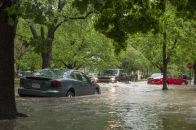This timely information from Dr. Londa Nwadike, food safety specialist for K-State Research and Extension and the University of Missouri Extension, first published May 6, 2015, was written by Connor Orrock. The publication “Food Safety After a Flood” is linked at the right under Learn More.
Floods can be devastating in a variety of ways. They damage property and can leave lasting effects on communities.  With cleaning up and reorganizing on the mind, consumers might not think about the consequences floodwater can have on foods.
With cleaning up and reorganizing on the mind, consumers might not think about the consequences floodwater can have on foods.
Floodwater often contains sewage or animal waste, which means harmful organisms could contaminate foods affected by floods. Some organisms found in floodwater might include foodborne pathogens such as E. coli and salmonella, which could cause foodborne illness, said Londa Nwadike, food safety specialist for K-State Research and Extension and the University of Missouri Extension.
“Floodwaters could also contain petroleum products such as gasoline and oil, which can cause nausea, vomiting, and other short and long-term effects if consumed in large quantities,” Nwadike said.
A recently released publication titled “Food Safety After a Flood” provides many helpful tips to aide in the cleanup process. Nwadike authored the publication and said the best advice she can provide is: “When in doubt, throw it out.”
The only foods that can be kept after exposure to floodwater are commercially prepared foods in metal cans and retort pouches, assuming they are not damaged, she said. Retort pouches are used to package items such as shelf-stable juices.
“All other foods exposed to flood water should be thrown away,” Nwadike said.
This includes foods in the refrigerator and freezer, as well as all foods in boxes, paper, foil or cloth. Also dispose of spices, seasonings and extracts. Consumers should throw away any home-canned foods exposed to floodwater, as it is difficult to properly disinfect the seals.
Other flooded foods stored in open containers, packages or canisters should be tossed out, as should foods with caps and pull-tabs, such as condiments and soft drinks.
The fact sheet includes information on how to properly sanitize undamaged cans, retort packages, cooking utensils, pots and pans, and kitchen countertops that have been exposed to flood water.
For these and other tips regarding food safety after a flood, visit the K-State Research and Extension Bookstore, or contact your local extension office.
Access the original story here.
